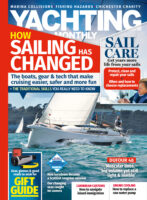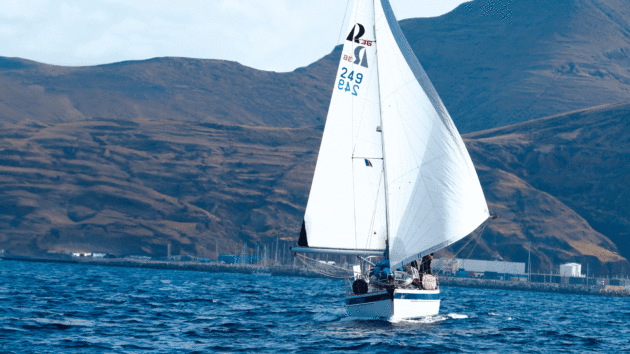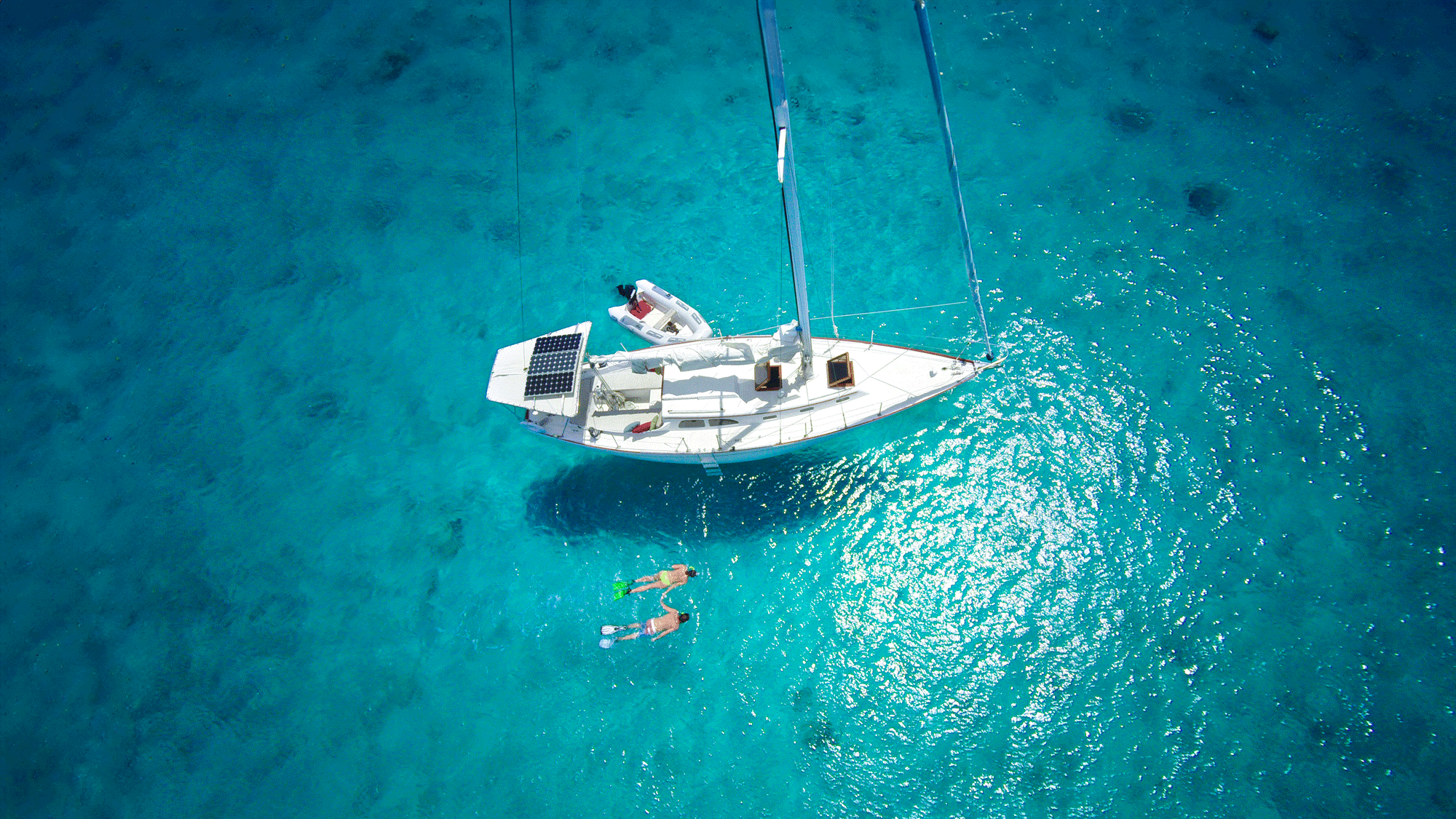It’s easy to dream about an Atlantic crossing, but actually doing it takes commitment and action. Justin Halewood explains how they did it, and what it cost
We dreamt of sailing the Atlantic for years, but we finally decided to take the plunge and make it a reality with our young daughter. ‘Procurement exercises’ are a routine part of my job, so it was perhaps inevitable that I was focused on the financial side of our year away – I have the spreadsheets to prove it!
I spent far too much time thinking about money both before and during our partial atlantic crossing (we made it to Florida before selling our boat Zoe) – and while everyone’s budget will be different, I’d like to share some of our lessons below, alongside a few ideas for how to get the best bang for your buck during your own adventure.

The view from Shirley Heights in Antigua – looking down at our boat Zoe on anchor in Freeman’s Bay, with Nelson’s Dockyard beyond. Photo: Justin Halewood
A question of priorities
The first one is about what the point of going is in the first place. Think less about costs and more about your experience – for many people an Atlantic circuit will be a once in a lifetime experience, so although you don’t want the project to be financially ruinous, you also don’t want to penny-pinch the fun out of your time afloat.
Examples of little luxuries we allowed ourselves included hiring cars to explore the places we landed, eating out and staying in marinas more often than many of our cruising friends (our daughter loved running up and down the pontoons making friends with other families). In our view, you can be in the middle of Caribbean paradise but if you’re stuck eating old provisions, in a rolly anchorage and unable to tour the island, you probably won’t be having fun.
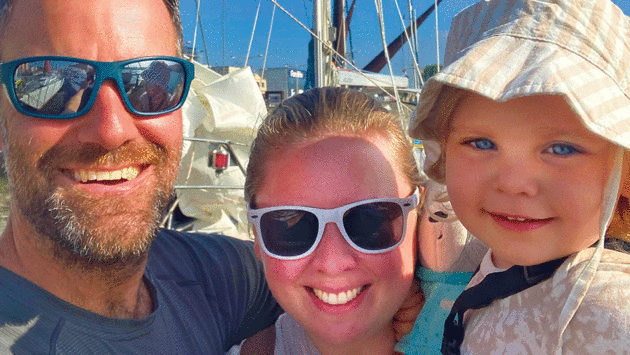
JUSTIN AND NICOLA HALEWOOD sailed their Hallberg Rassy 36 to the US with their daughter in 2022. They are now back living in Portsmouth
Better to ease the purse strings a little and capitalise on the opportunities your travel presents. To do this you’ll need to either mentally accept the expense and draw down on your savings or generate income to offset costs.
False economies
Beware of false economies – given how expensive yachting can be, the temptation can be to take the cheap option when considering spares and maintenance. This can leave you in the counterproductive position of having to spend even more once you’re underway and things start to break.
We had to pay roughly four times the amount we’d typically spend to replace our batteries in Antigua due to a mistake I’d made in the specification of our electrical system.
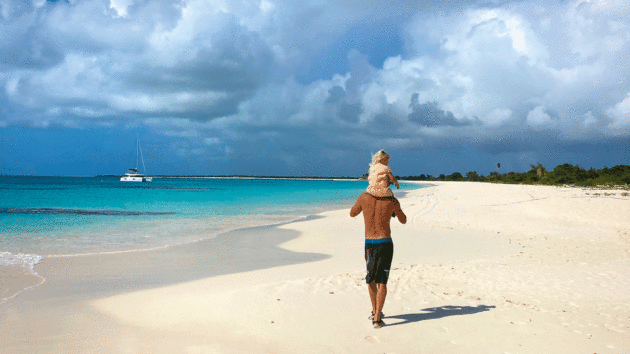
A mixture of stunning anchorages and interesting exploration makes a trip memorable. Photo: Justin Halewood
If you can, try to shake down the boat properly before leaving, ideally for a whole season before setting off. You’ll benefit financially and have a lower chance of being stuck somewhere wasting time and money.
Article continues below…
How to sail sustainably: ‘The Atlantic taught me how to calculate a boat’s carbon footprint’
For nearly three decades, I have been deeply involved in shaping environmental solutions across many industries, from agriculture to aviation.…
The Atlantic Rally for Cruisers: ‘The Atlantic was tough, but being prepared saw us across’
Crossing the Atlantic to cruise the Caribbean was a dream long in the making; my planning was meticulous, so, come…
Choosing a boat
The same goes for the purchase of your boat itself – we had a strict budget and elected to go with a reasonably priced monohull (we paid in the region of £60k for our 36ft Hallberg-Rassy).
We had planned to rent out our house in order to generate a passive income to offset our expenses, but later in our preparations we changed our minds part way through so we had more cash available.
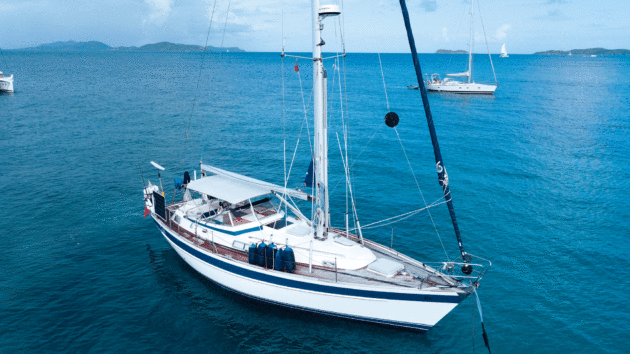
Having committed to a moderate displacement, small-ish monohull, Justin might have gone for something bigger and faster in hindsight. Photo: Justin Halewood
In retrospect at this point we should’ve revisited our boat selection and thought again about whether we had deployed our capital in the optimal way.
A 36ft boat is ideal for most forms of offshore cruising but quite small for a family of three to live on for a prolonged period. The loss of passive income from our capital now feels like a fair exchange for the improved experience from buying a more expensive boat.
Linked to this was our observation that at the right age, at least in the current market, boats don’t seem to depreciate a huge amount, particularly those that have been upgraded for bluewater cruising – so there is limited downside risk (unlike being invested in the stock market).
If (when) sailing away again, we’d be tempted to buy a multihull, investing our cash into a boat that would provide greater comfort and speed.
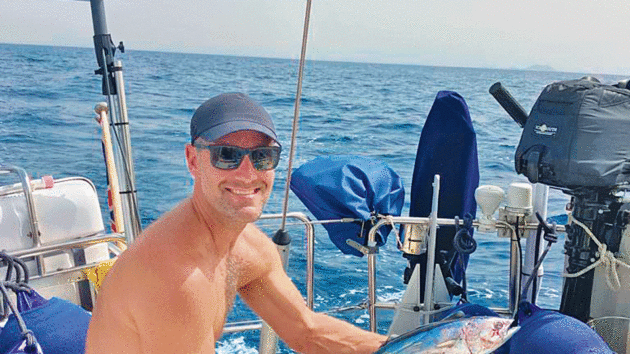
Fishing while afloat helps keep everyone fed. Photo: Justin Halewood
Shop wisely
Provision intelligently – it’s hard to convincingly describe how expensive even basic provisions can be in the Caribbean. Depending on the island, it can be near impossible to avoid paying sky-high prices for basic supplies such as rice, pasta, meat, vegetables and even fruit.
Like pirates looking for buried treasure, you’ll be searching for the best supermarkets in the Caribbean – for instance, we heard a rumour of a fantastic carrefour buried somewhere on Guadeloupe.
I can already see the social media comments saying we should’ve bought local produce – even local fruit and vegetables can be very expensive in comparison to Europe.
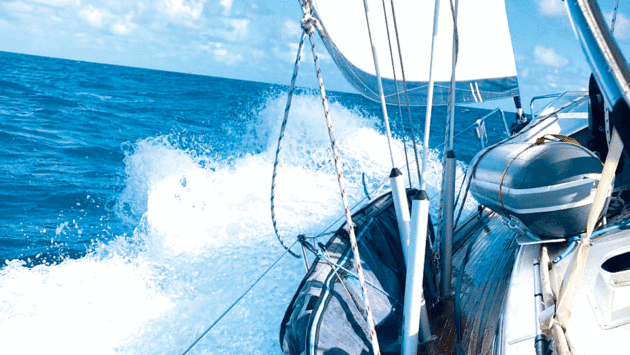
Sailing back across the North Atlantic puts some off from sailing home, who then sell their boats in the US. Photo: Justin Halewood
To help avoid the financial hit, fill your boat with provisions in the canaries before leaving, not just for the Atlantic passage but to help sustain you for as long as possible afterwards too. An onboard freezer can also be extremely helpful when eeking out the life of your stores and enable you to stockpile the fish you’ll catch during passages.
Many of our sailing friends ended up with 12v portable freezer boxes strapped under saloon tables and on spare bunks.
Working remotely
Globally available internet, in particular thanks to Starlink, means anyone can be online anywhere and at any time, so working from on board is entirely feasible. However, do think about whether to continue working. I regard it as a mistake that I chose to work remotely while we were away.
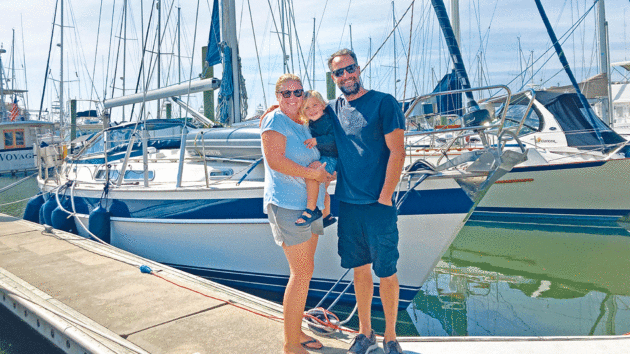
Occasional marina stays are fun, and often aren’t as expensive as you’d imagine. Photo: Justin Halewood
The experience of being a digital nomad felt liberating compared to the normal office drudgery, but it still came with the usual work politics and pressures.
Feeling stressed about a work deadline while sat on anchor in Bitter end, bvis is a memory that comes to mind – i should’ve thought more carefully about whether the relatively meagre income my consulting produced was worth the time away from the experience, both physically and mentally – and the answer is, it probably wasn’t.
Marina choices
Use marinas selectively
In many cases, marinas have quite rightly gained a reputation for blowing holes in cruiser’s budgets. But in others, they offer genuine value for money when compared to the alternative, and therefore shouldn’t be discounted entirely in our opinion.
Examples include being quoted $200 per night for a berth in nassau; this was however a close call as we needed to catch a flight to the us.

Starlink transformed Justin’s ability to be online whilst on the boat. Photo: Justin Halewood
In the end we elected to leave the boat at anchor. We paid an average of €15 per night for a full-service marina in the spanish rias, and although many of the anchorages were perfectly nice, it was hard to justify the inconvenience of launching our tender and losing shore access at that price.
When we arrived in west palm beach in florida we had the option of paying upwards of $100 a night for a private marina berth or using a free municipal pontoon, albeit where we would sit in the mud for a few hours each day – an easy decision.
The choice of whether to anchor or tie up is purely personal, but our recommendation is to weigh up the options objectively and not become emotionally or ideologically wedded to one over the other.
Sort your life admin
Prepare your finances for a globe-trotting life. Alongside getting the boat ready, don’t underestimate the amount of admin before leaving; doing this right can help save money.
Examples include reviewing your boat insurance – most typical policies won’t cover you much beyond spain and some may not even cover you for biscay. We realised this only after leaving and finding reasonable cover was surprisingly difficult.
I’m sure we could’ve got a better price with more time to research and shop around. The same goes for your mobile phone contracts, bank accounts, medical insurance and visas.
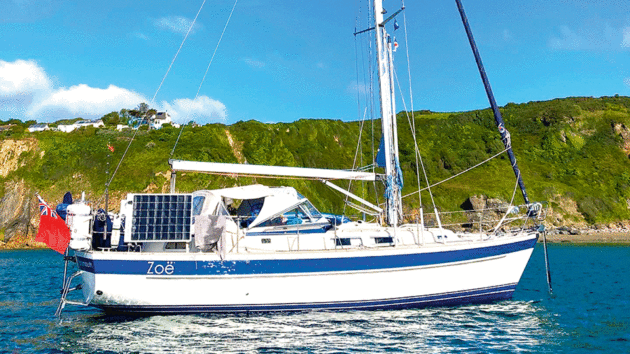
Zoe was well kitted out for cruising away from shore power and water. Photo: Justin Halewood
1-minute briefing
Best and worst upgrades
Best – Starlink the hardware (‘dishy’) was around €400 and we paid around €80 per month for unlimited data. I believe prices change frequently but having access to the internet anywhere meant i could work as a digital nomad. It was a good feeling to have a back up to our iridium go when offshore. Least necessary perhaps the cruising chute.
Not a bad sail but we much preferred twin foresails for their stability (less flapping), ability to reef and use through a greater range of wind angles.
Choosing a route
We sailed from the uk, along the Atlantic coast of France, Spain and a Portugal. Then Madeira, the Canaries, across to the Caribbean, up through the BVIs, Domincan Republic and the Bahamas before crossing the gulf stream to Florida. We tried not to determine our plans too far in advance and instead focussed on ensuring the boat was equipped to take us anywhere (including into the Pacific).

Justin and Nicola Halewood sailed their Hallberg Rassy 36 to the US with their daughter in 2022. They are now back living in Portsmouth
We used almanacs, cruising guides, lonely planet guides, apps like navily and lots of conversations with fellow cruisers to decide where we ended up. We then tried to work around weather windows and often adjusted our plans to better suit wind direction and sea state.
Atlantic highlights
We learned that everyone has different experiences and preferences but our highlights included:
1. The Spanish rias great food, calm anchorages, cheap marinas, beautiful beaches – you just have to be mindful of the orcas attacking boats!
2. Madeira a beautiful island with great hiking, even cheaper marinas and salt water swimming pools.
3. The British Virgin Islands very busy with charter boats but you can still find an uncrowded and idyllic anchorage if you look hard enough.
4. The exhumas, Bahamas white sand, crystal clear water, quiet island life.
What to skip
We found St Martin to be scruffy and touristy. St Barts was a spectacle but we felt out of place amongst the super yachts! The next time we go we’d be tempted to spend more time in the Bahamas rather than the Caribbean.

The cruising chute was a great sail, but potentially less useful downwind. Photo: Justin Halewood
Sail home or sell?
We sold our boat in St Augustine, Florida due to a preferential exchange rate and good resale value. We’re still in contact with the new owner and are confident Zoe went to a good home!
Totting up the bill
So to the brass tacks – we spent an average of £4,208 per month or £2,103 per adult. Across a year this meant £50,496 of costs.
Amount spent monthly (on average)
Off-season storage: £0 – Originally provisioned to allow for hurricane season – not required in practice
Insurance: £102
Sat phone/WiFi: £50
Mobile phone subscriptions: £86
Standing orders: £76
Fuel/water/gas: £307 – We motored more than expected!
Marina fees: £591
Laundry: £19
Provisioning: £525
Health insurance: £0 – Partially covered by our main policy
Repairs/replacement: £760 – Included in this is a new tender and outboard
Eating out: £728
Travel: £806 – Flights to and from home on a number of occasions for both Nicola and Robin, alongside flights to the US. The occasional holiday rental with friends and family.
Visas etc: £215
Sales: £200 – We actually made a bit of money by selling unnecessary spares etc
Excursions: £419 – Hire car costs and various small trips
Total per month: £4,208
Total per person (adults): £2,103
Total per annum at run rate: £50,496
Total per annum per person (adults): £25,248
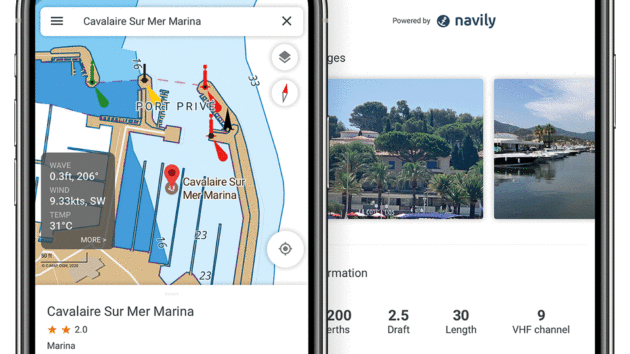
Research on apps like Navily shaped decisions
Income
We also generated a net and post-tax income of approximately £38,800 between us, split roughly 40% from income from rental properties and 60% from consulting work. Despite Liz Truss’s best efforts, we also saw some appreciation in our stock market investments (funded through the sale of our home) that meant we exited our year afloat with a slight improvement to our household profit and loss.
Unseen costs
This is all only part of the story, however. To get a fair accounting of the real impact to our ‘balance sheet’, we also needed to recognise the following: We spent approximately £60k on upgrades to our boat before we left. This included luxuries like a watermaker so can be considered on the high side. We recovered around £40k of this when we sold our boat, leaving us with a £20k sunk cost.
After much thought, we decided to sell our primary residence before leaving. Our reasons included wanting to release capital to invest and generate passive income rather than managing tenants; and avoiding wear and tear from renting.

Make sure you have insurance in place before heading for the horizon. Photo: Justin Halewood
In retrospect selling our house was an expensive mistake. House prices rose while we were away and we’ve had to pay stamp duty to get back on the housing ladder since returning. Netting off the income from the stock market investments enabled by the sale of our previous home, I’d conservatively estimate the cost of this at £30k.
Both myself and my partner Nicola were working in relatively well-paid jobs before leaving. We missed 18 months of savings, pension contributions and career progression. I’d estimate the cost of this at £30k.
These costs can be hard to predict, avoid and measure but the numbers add up (in our case) to around £80k. A major lesson for us therefore was to think more about the big financial decisions involved in detaching from ‘normal life’ and to be less concerned about trying to offset day-to-day expenses while onboard.
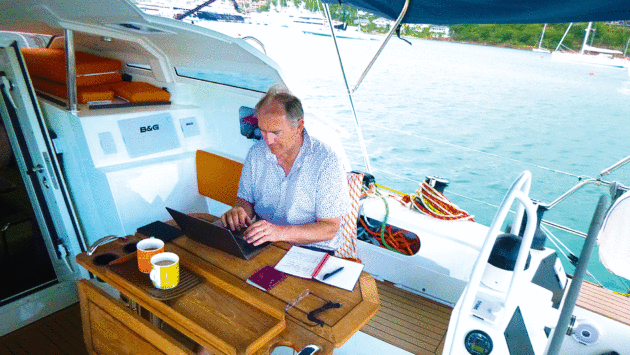
It’s possible to work anywhere in the world now, but do you really want that to be part of your trip? Photo: Justin Halewood
Enjoyed reading this?
A subscription to Yachting Monthly magazine costs around 40% less than the cover price, so you can save money compared to buying single issues.
Print and digital editions are available through Magazines Direct – where you can also find the latest deals.
YM is packed with information to help you get the most from your time on the water.
-
-
- Take your seamanship to the next level with tips, advice and skills from our experts
- Impartial in-depth reviews of the latest yachts and equipment
- Cruising guides to help you reach those dream destinations
-
Follow us on Facebook, Twitter and Instagram.
Note: We may earn a commission when you buy through links on our site, at no extra cost to you. This doesn’t affect our editorial independence.

